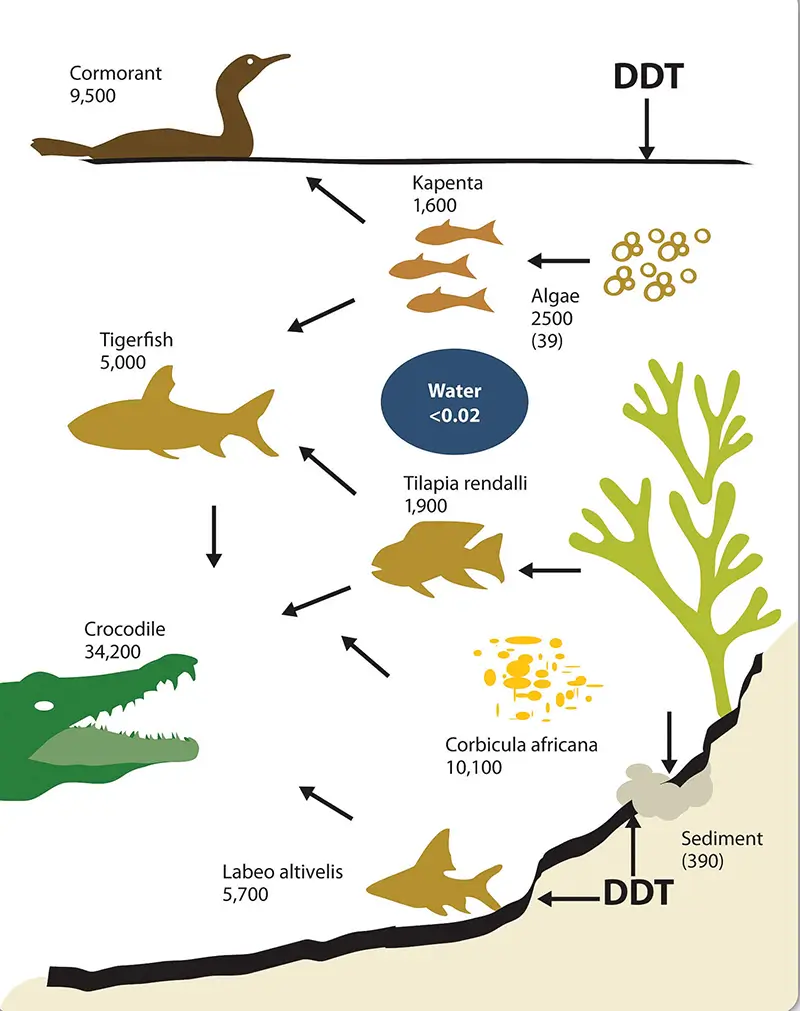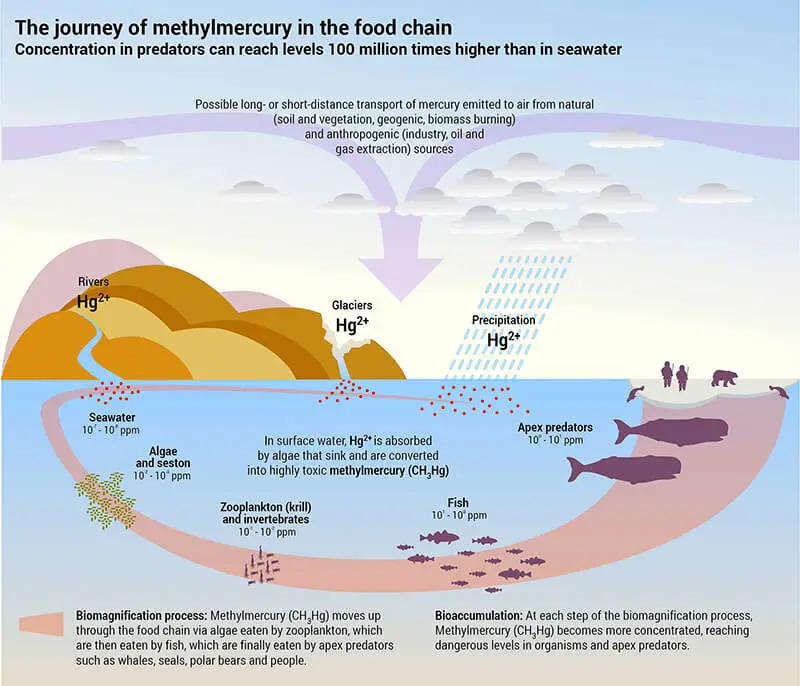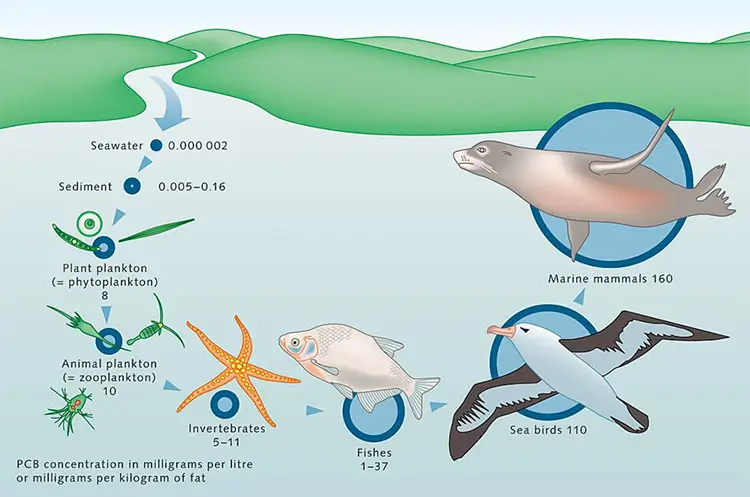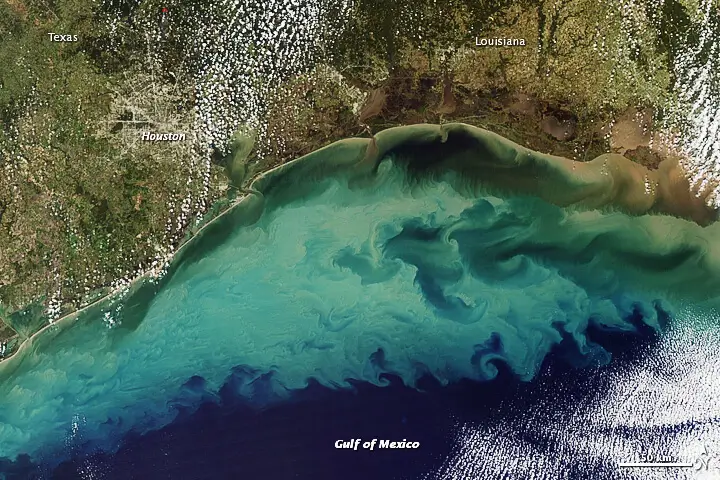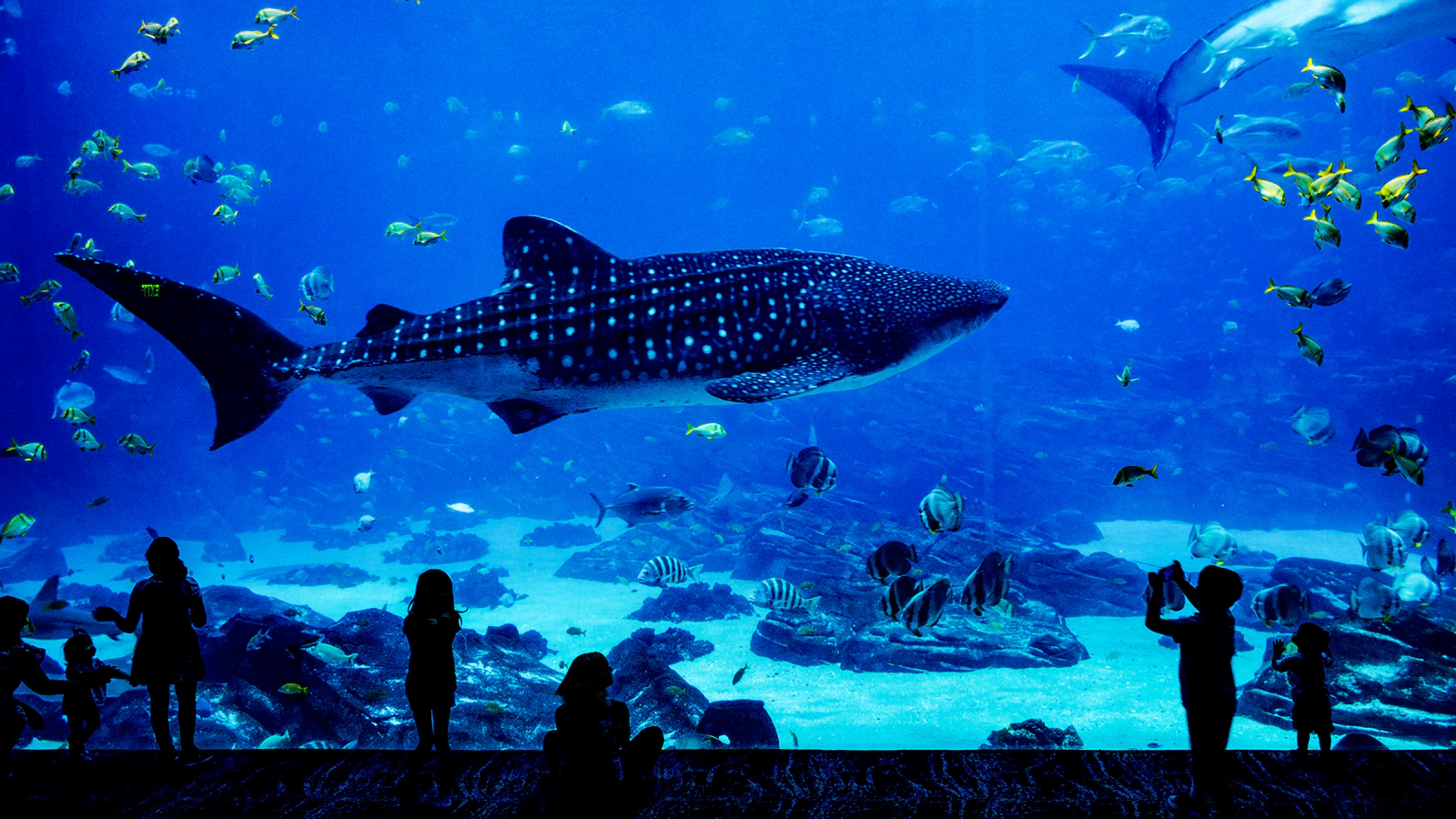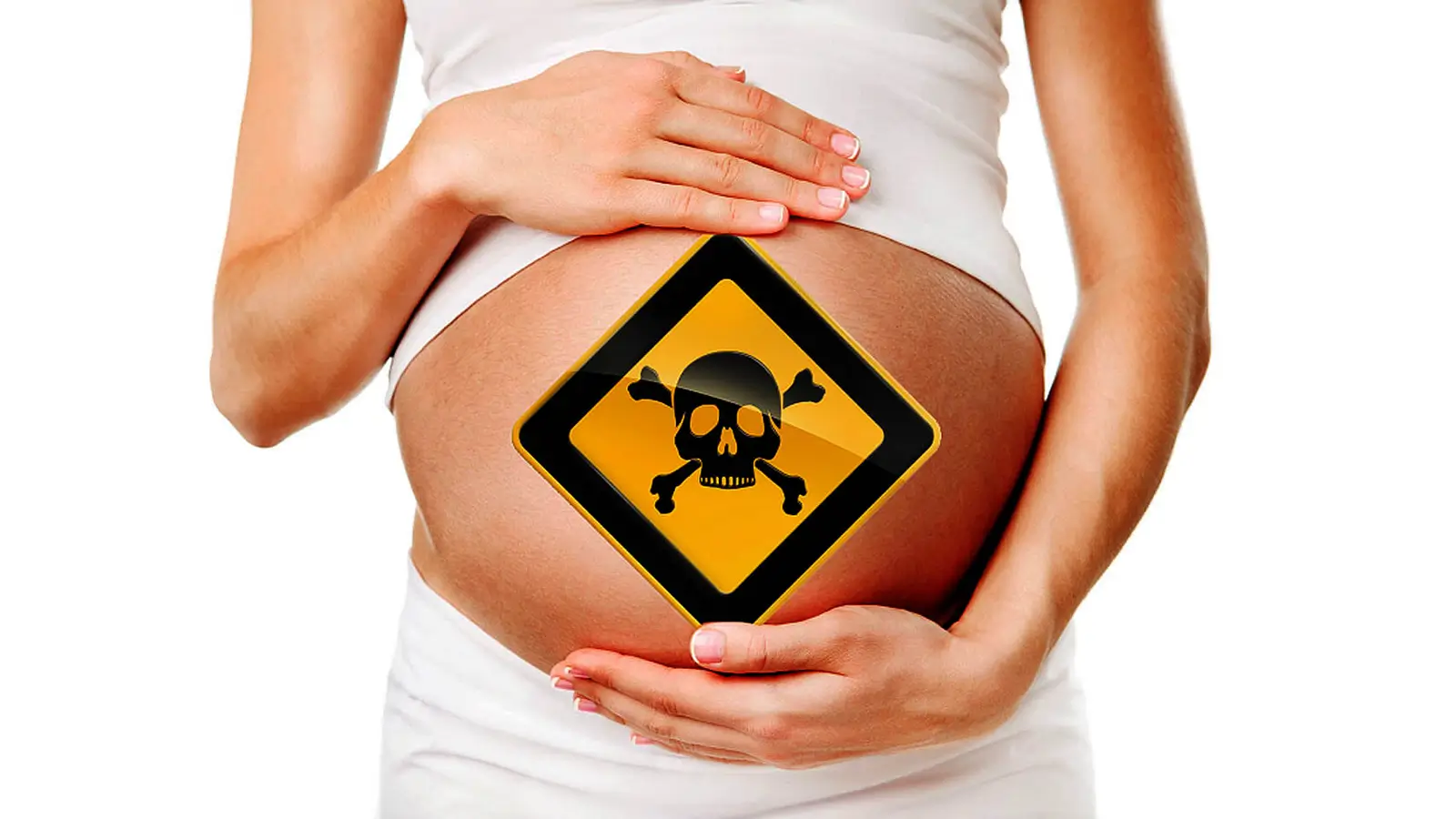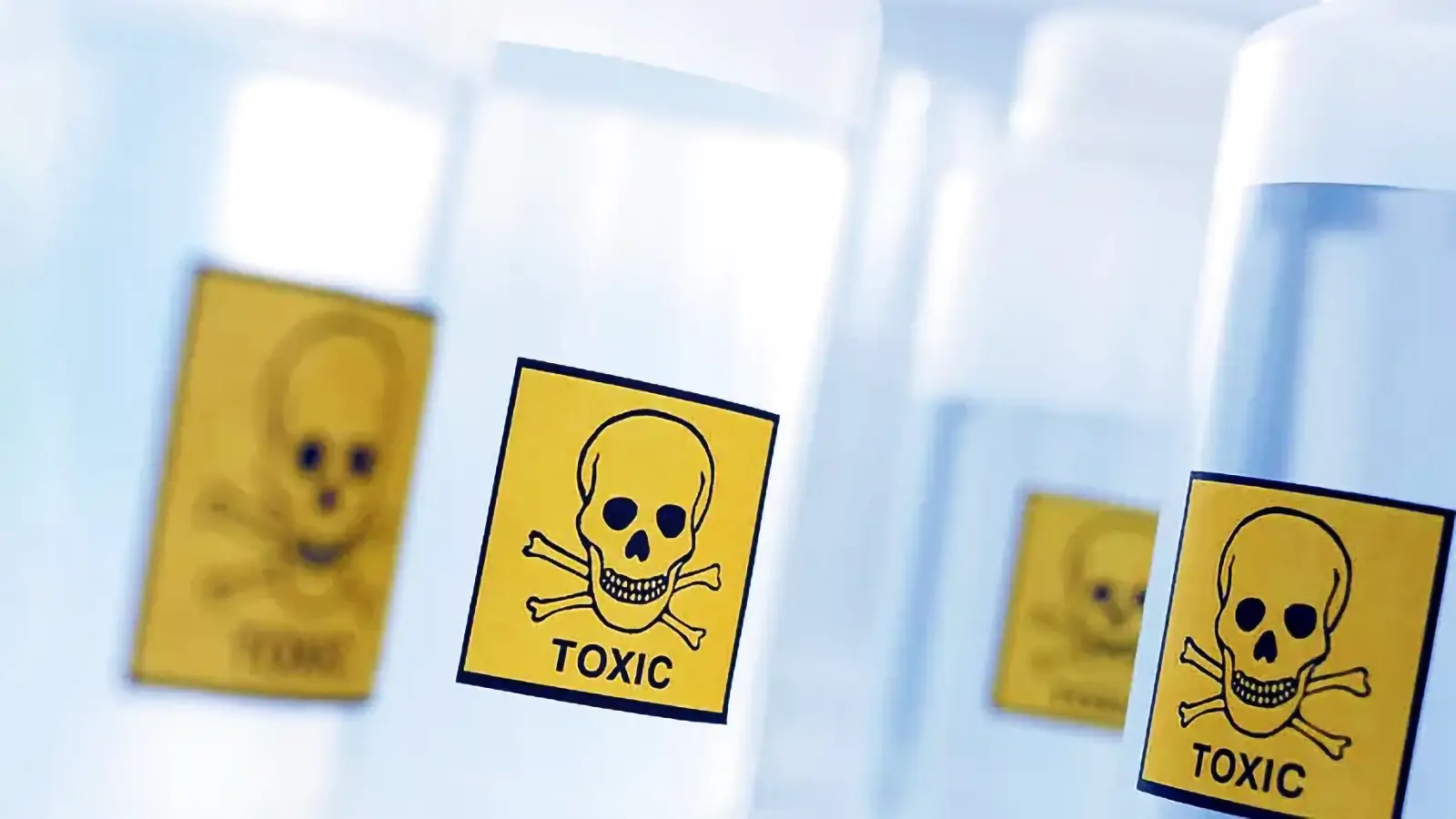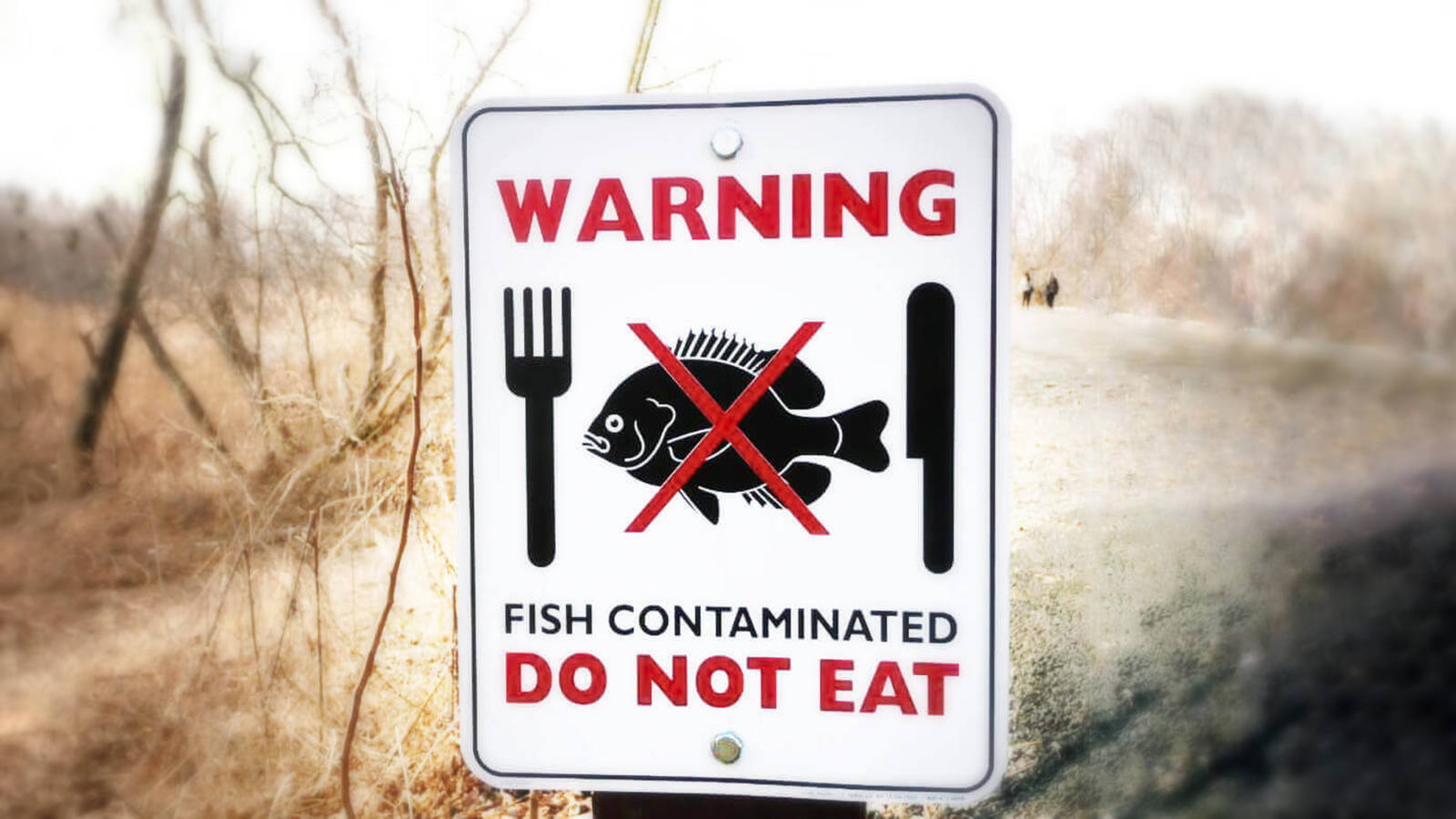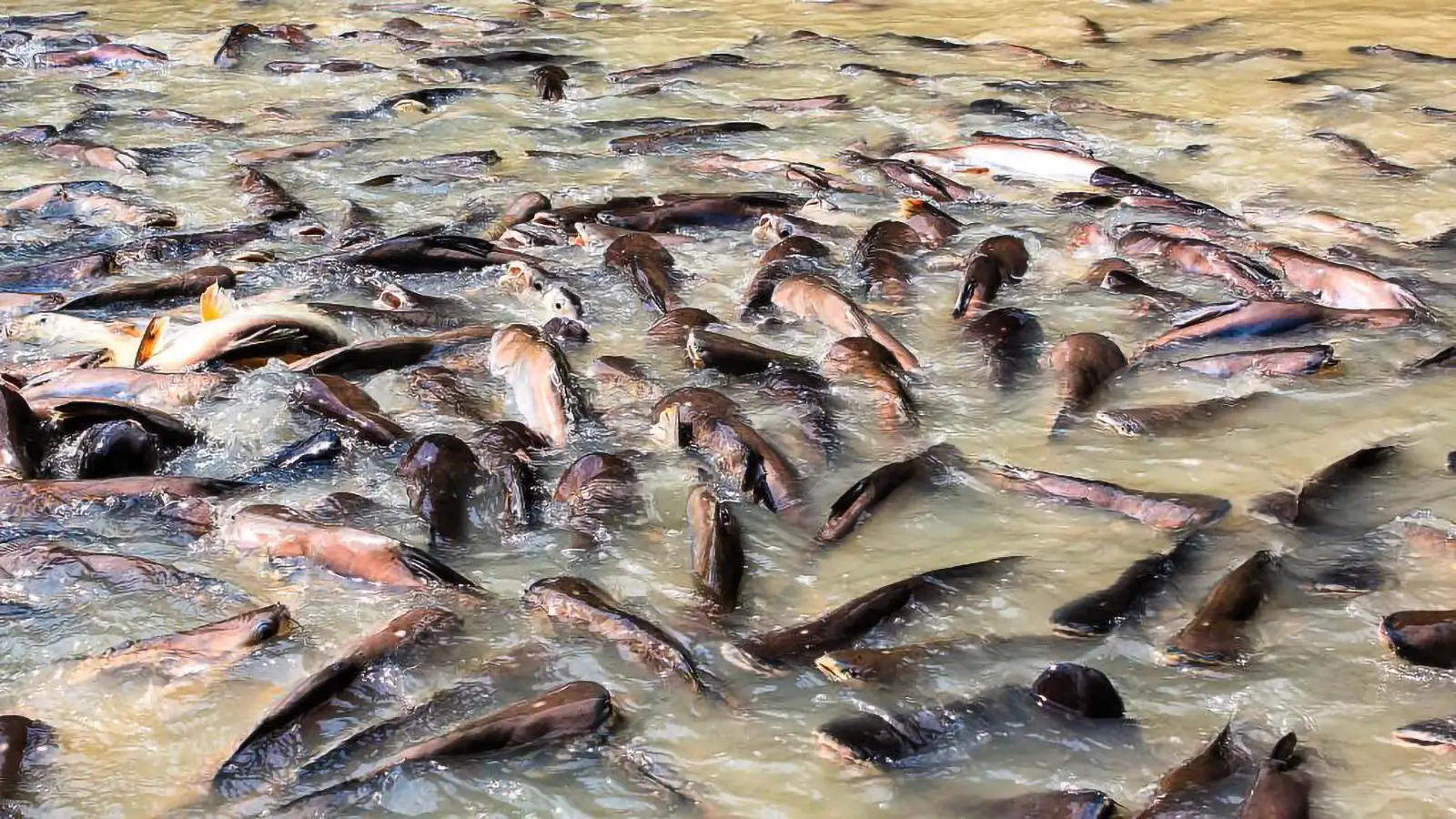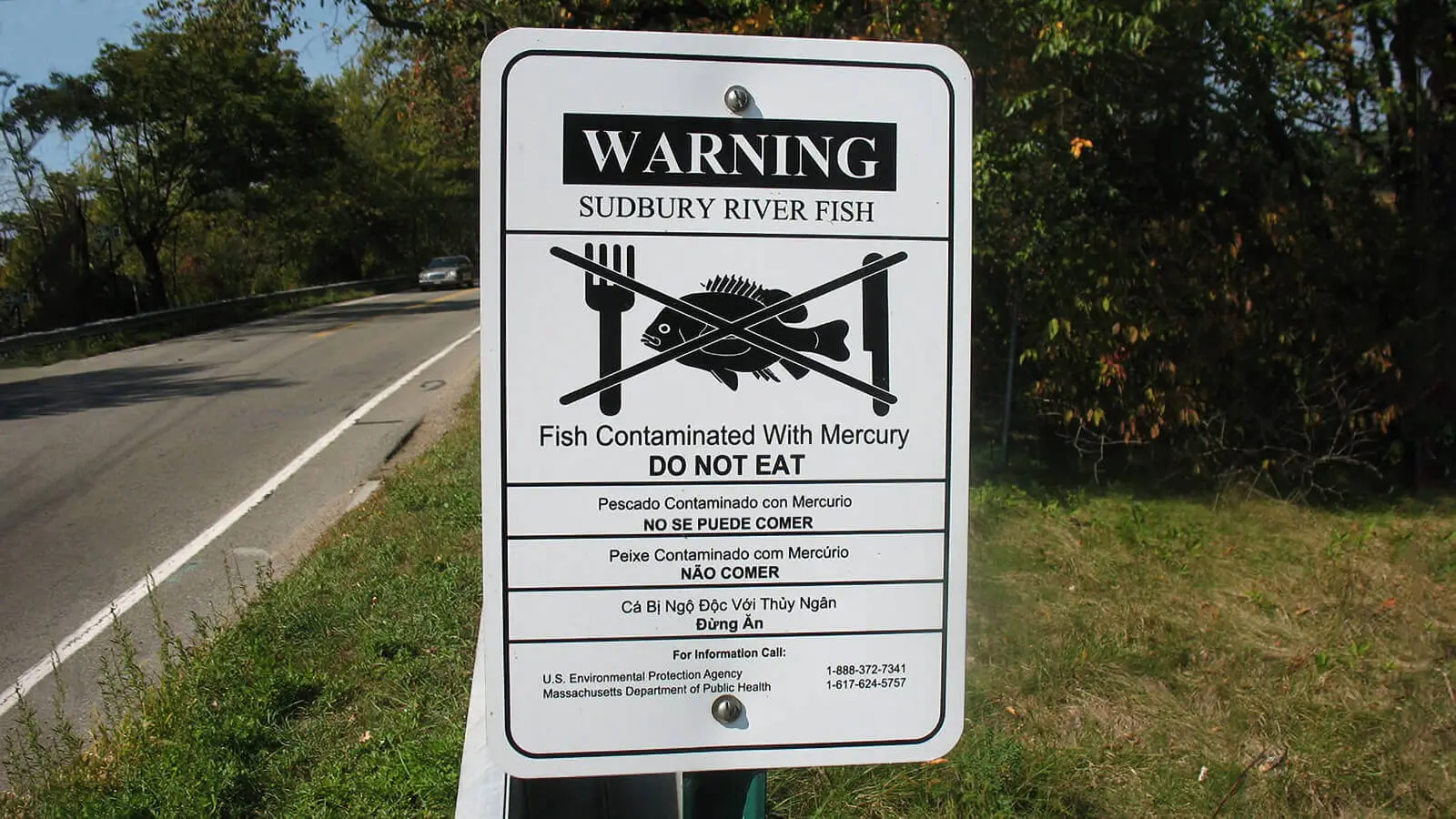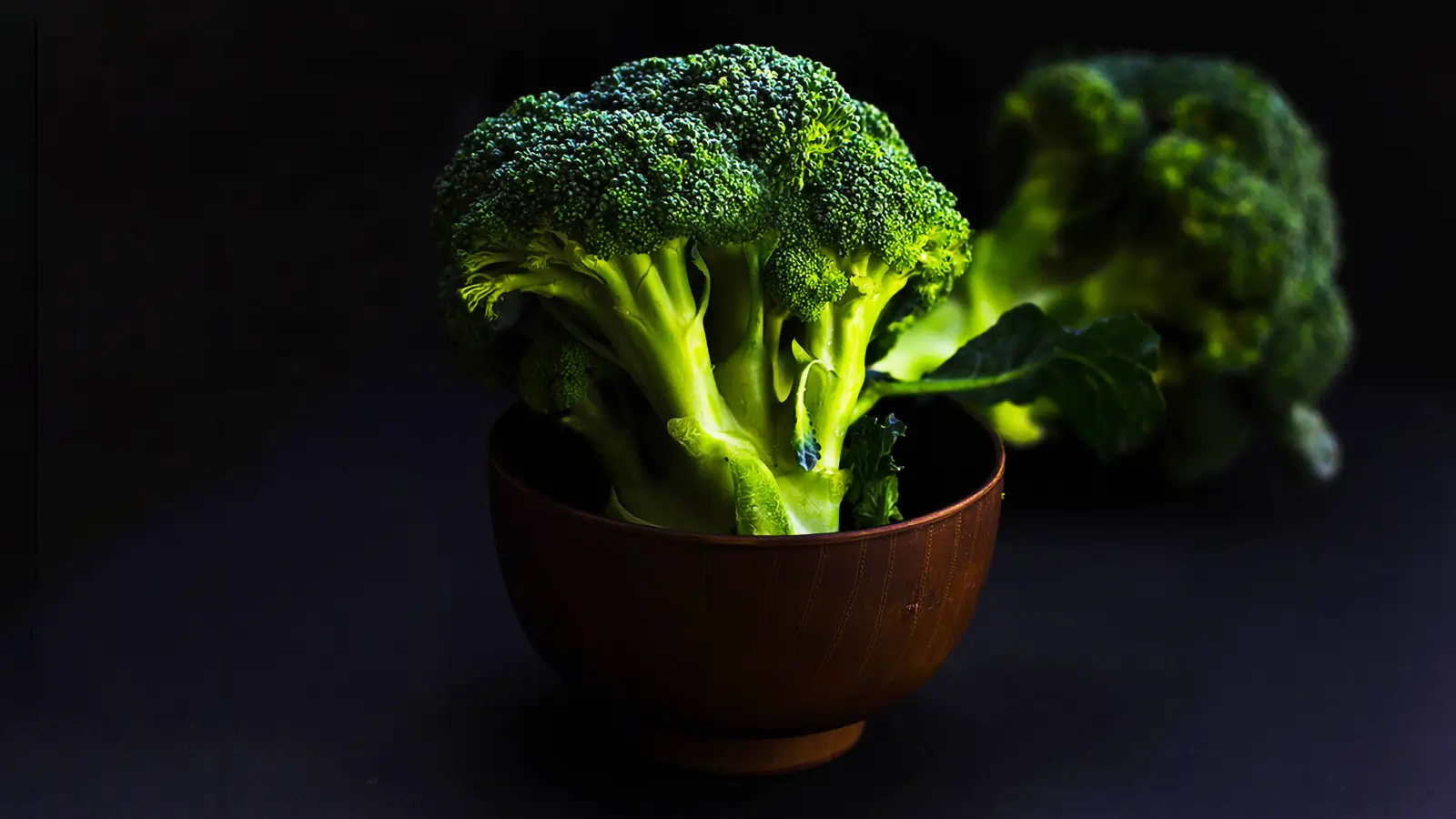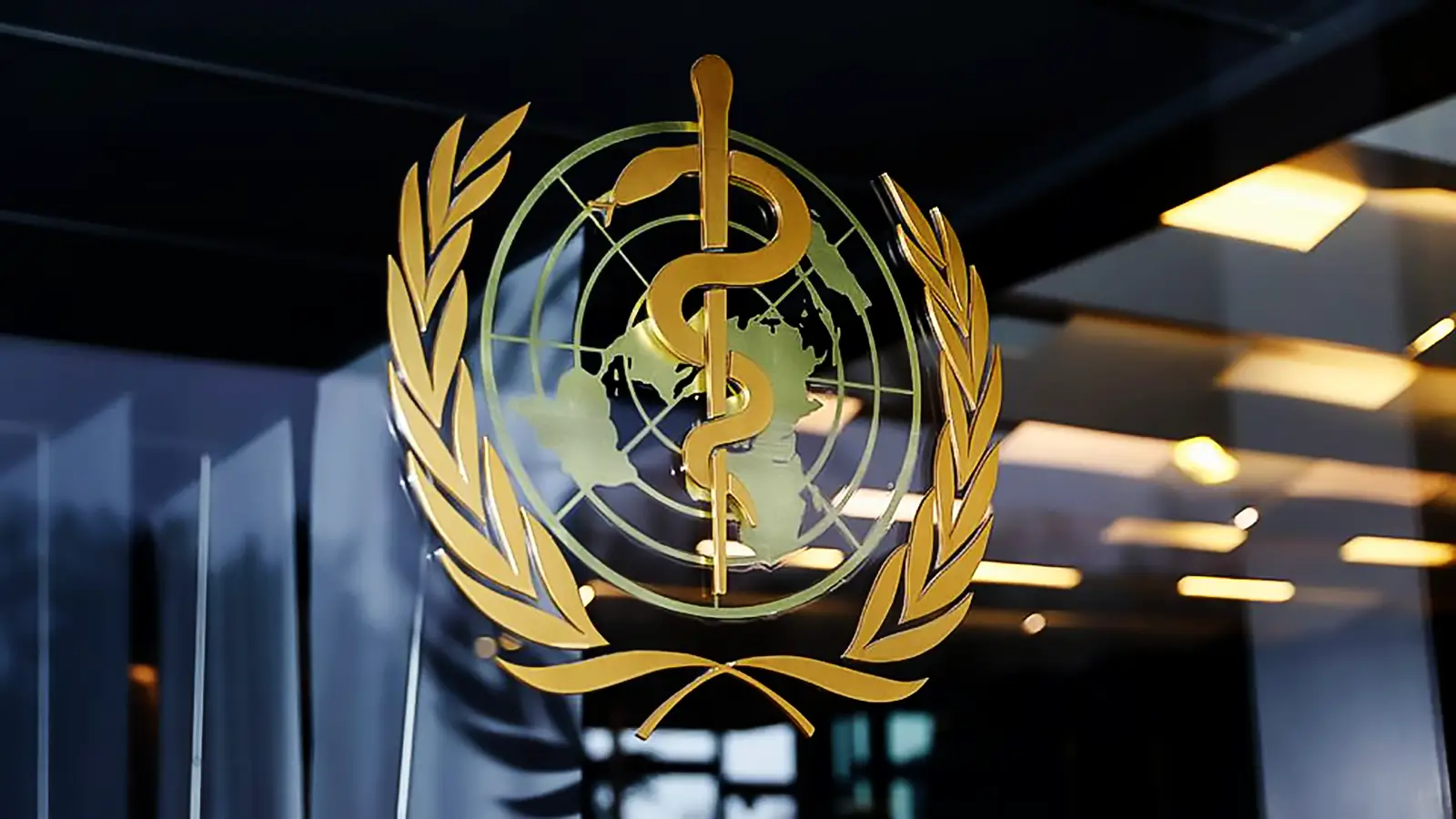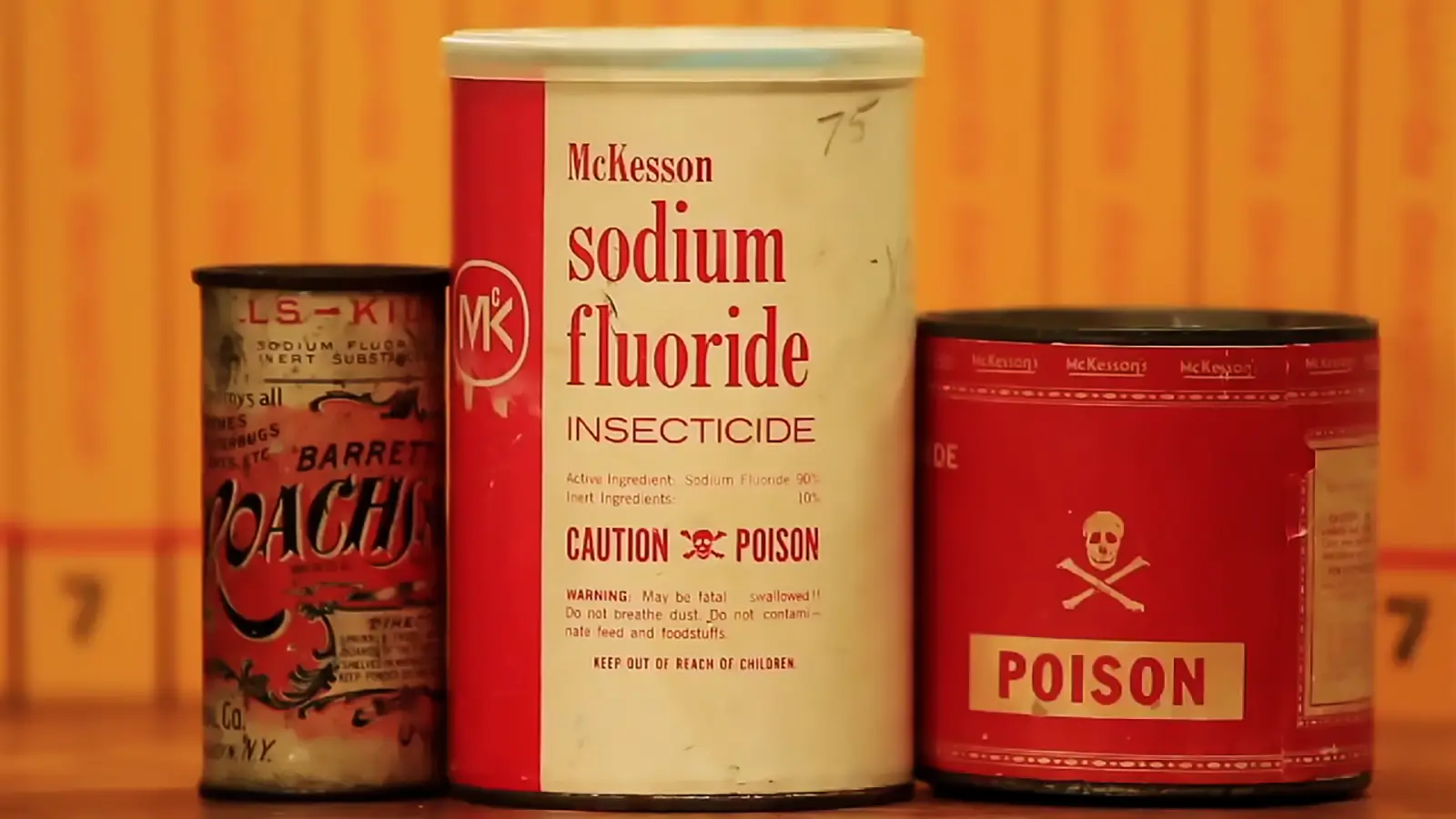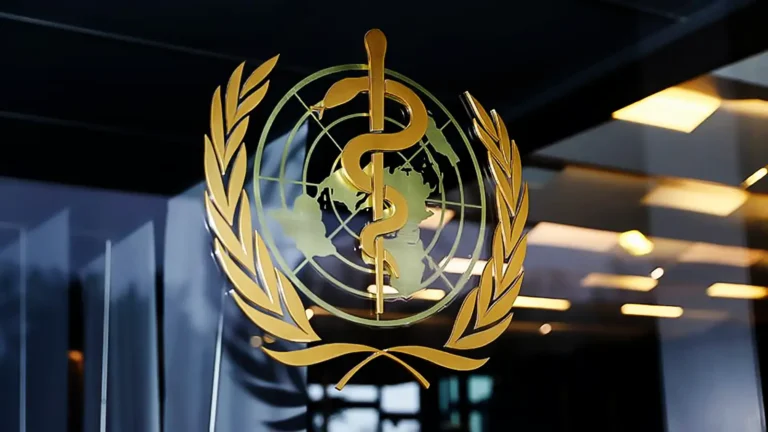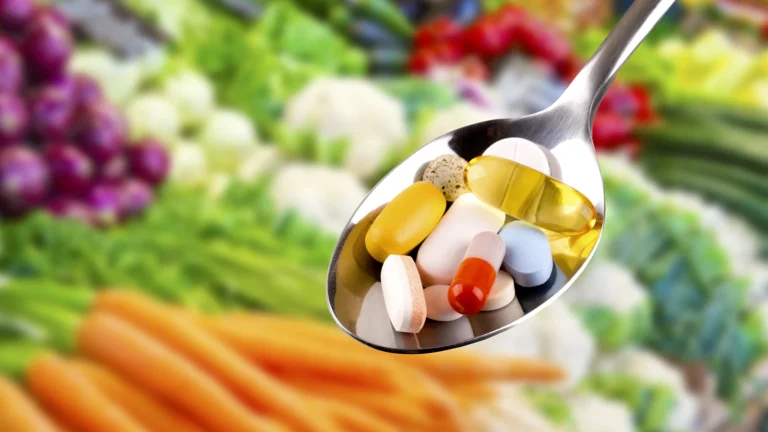Fish toxicity- The most toxic meat
Pollution is washed away and will end up in the ocean eventually and algae filter the water starting the bioaccumulation process. Fish toxicity is a big concern.
Milos Pokimica
Written By: Milos Pokimica
Medically Reviewed by: Dr. Xiùying Wáng, M.D.
Updated June 9, 2023Most of the pollution is washed away and will end up in the ocean eventually. If the pollutant is persistent it will remain in the ocean creating a situation where fish toxicity is a big concern. The concentration in the ocean will be low but the plankton and algae will filter the water and then the bioaccumulation will begin.
When higher organisms feed on these microorganisms they will consume all of the filtered toxins from the seawater as well and as we move up the food chain the concentration of the environmental toxins will build up. The end result will be that although the levels of pollutants will be minuscule when measured directly in the seawater when measured in the top predatory fish in some cases the levels will be severely toxic. Eating these types of fish will be severely pro-inflammatory, neurotoxic, pro-cancerous, and toxic in general. The pollution today is so great that even if we disregard all of the other bad effects of meat consumption that I have analyzed in other articles and books and topics just human-made pollution is enough to be a reason to never touch anything that comes out of the ocean especially if you are pregnant or if you are a child. Fish is everything except a healthy meat source. Farm-raised fish is, if you can believe this, even worse because of the conditions in the fish tanks and the food pallets that are used as feed for the fish. It is highly unlikely that you will be able to find organically raised farmed fish on an economically and environmentally sustainable basis and even then the condition in these fish tanks will be filled with bacteria and will be filled with pollution.
Scientists in the study I already mentioned about fish consumption, methylmercury, and child neurodevelopment (Oken et al., 2008) in the article about fish consumption and mercury also included a warning for the consumption of Docosahexaenoic acid (DHA) in conclusion. Omega-3 or chemically Docosahexaenoic acid (DHA) is a fatty acid that has a role as a structural component of the cerebral cortex primarily but also the entire human brain, retina, and skin. Meaning if you cut out fish from the diet you need to find some other source of omega-3 fatty acids that are not from fish. They know that people believe in eating fish as a healthy habit because of healthy omega-three acids so they must find another source. They are correct and we do need Omega 3 fatty acids and people will disregard any if not all of my advice because they like to eat meat number one and number two they just need an excuse and number three they do believe that fish is a healthier choice because it lacks the level of saturated fat that pork has and it does have an omega 3 fatty acids that we need for our brain.
However, from where did the fish get omega 3s in the first place I wonder? Supplements like fish oil are heavily polluted as well. America consumes more than 200,000 tons of fish oil a year. They concentrate the omega 3s but also concentrate all pollutants from fish, not just mercury but PCBs and insecticides, and all others. The molecularly distilled is no different. It is just another scam. Molecular distillation of fish oil can only remove some of the toxins, but most remain. It has a fancy name, but so far it is useful only for lighter organic contaminants (Hoh et al., 2009).
The only possible solution for fish toxicity and toxicity, in general, is to go lower on the food chain. Krill oil should be purer than fish oil. Krill have a high mortality rate and live short and are low on the food chain so they would not have as many pollutants. Going all the way to sea vegetables is the best course without supplementation especially because we can get more other minerals like iodine and phytochemicals when eating sea vegetables in a salad than just taking algae-based or krill-based DHA supplements. Our oceans are by now so polluted that even low-level organisms can be contaminated. Especially after algae blooms and all of the neurotoxins that this form of algae can create.
The wide variety of chemical pollutants is a concern. Even polar bears now have renal lesions, reduced bone mineral density, fatty liver, and chronic inflammation due to fish toxicity (Sonne et al., 2005). The dolphins too (Vetter et al., 2001).
Organohalogen compounds are PCB congeners, DDT and metabolites, chlordane-related compounds, and so on. The effect of POP (Persistent organic pollutants (POPs), sometimes known as “forever chemicals”) on human health and also on the environment is real, and even if we think that it is something we can ignore the situation is not as such. The international community made the intention to restrict production at the Stockholm Convention on Persistent Organic Pollutants in 2001. However, the real story is that we cannot. They are an essential part of modern agriculture and different type of industries. Not everything can be recycled and purified. POP can evaporate too and enter into the atmosphere. Because they are resisting breakdown reactions in the air and are stable, they can travel long distances. Then they will fall and be re-deposited. This results in an accumulation of POP in areas far from where they have been used or emitted. They can reach as far as Antarctica and the Arctic Circle. We do not have a clean life anymore because there is no natural way to produce food organically for billions of people on the planet.
Some of the most known POP are for example Polychlorinated biphenyls (PCBs), Dioxins, and Dichlorodiphenyltrichloroethane (DDT). PCBs are used in plastics, as additives in paint, in electrical transformers, and capacitors, in carbonless copy paper, and as heat exchange fluids. So no plastic and electronics without them. PCBs are poisonous to fish at high dosages, and correlated with spawning failure at low doses. In humans, PCBs are associated with immune suppression and sterility, and most exposure comes from food. Today one in six couples has trouble conceiving a baby. The number of couples attempting therapeutic methods due to the problem of natural conceiving has risen dramatically in the post-WW2 period. A number of 15% of couples that are sterile are more substantial than in the past for example 100 years ago. Sperm counts in the average male have fallen by almost half in the past 60 years. Fertility is lower in all men and women, and as a result 1 in 6 couples are sterile. Many experts blame this fall on the increase in environmental chemicals that have weak estrogen effects, such as DDT and PCB. An increase in estrogen levels in the general water supply, due to the use of oral contraceptive pills, has also been implicated. There are many chemicals in this world today.
In this study (Rozati et al., 2002) they measured the correlation between sperm count and environmental estrogens. When they talk about environmental estrogens, they do not mean phytoestrogens made by plants but xenoestrogens, pesticides like PCP, DDT, or BPA from plastic, and so on. Most of them were found in fish. Urban fish eaters have the highest average PE and PCB levels. In infertile men, the total motile sperm counts are correlated with their xenoestrogen exposure. They also found substantial correlations between PCB levels and ejaculate volume, motility, vitality, and osmoregulatory capacity. Higher PCB levels were associated with sperm damage (p < 0.05). Phthalates were also significantly higher in infertile men with higher phthalate levels being correlated with sperm DNA damage. Both PCB and phthalate concentrations were correlated with a decrease in total mobile sperm counts as well. The conclusion was that PCBs and PE (phthalate esters) might be influential in the deterioration of semen quality in the general population with particular attention being made as a contributing factor to infertility in men. Sperm count was something in the line of 10 (mean motile) live mobile count in millions for fish-eaters and above 80 for vegetarians. Around eight times the difference.
If fish toxicity does not make you sterile by lowering sperm count, it will cause reduced testosterone and other pro-estrogen diseases both in men and in a woman too like breast cancer, early menopause, endometriosis, and thyroid hormone problems. Many of the pesticides act similarly and have endocrine disruption potential. For example, we know that hypospadias, a birth defect of the penis where the opening is not at the tip but on the other side of the penis is caused by the fungicide Vinclozolin (Vilela et al., 2007). Do you still think that eating wild-caught salmon is health-promoting?
Dioxin is an industrial pollutant of Agent Orange’s story. Dioxins are also created as a byproduct of high-temperature burning. They are emitted when hazardous waste, hospital waste, and municipal waste is burned. Also, conventional combustion creates them like automobile emissions, coal, wood, and peat. They end up in the air and then get washed by rain and end up in the oceans. So are we going to stop driving our cars? We did cut out lead from gasoline, but that is just lead. Dioxins are scientifically proven to be a human carcinogen and have been linked to enzyme and immune disorders as well. In laboratory studies, they were also associated with an increase in congenital disabilities and stillbirths. Adverse health effects may include reduced testosterone, early menopause, endometriosis, cardiovascular disease, altered immune responses, thyroid hormone irregularities, diabetes and metabolism alterations, and skin, tooth, and nail abnormalities. During pregnancy, exposure can result in altered thyroid, immune system, brain, and reproductive organ development. Animal food, not just fish but all meat and dairy as well is the primary source of human exposure to dioxins. EPA started testing Americans for dioxin levels back in 1982. “Only” after three decades of delays in 2012, they released new guidelines that would set limits on the safe exposure of U.S. consumers. The response of the industry was to put political pressure on the White House. American Meat Institute, National Chicken Council, and other industry groups pressured the politicians that they are lobbying that with these new guidelines for their products:
“Could arbitrarily be classified as unfit for consumption.”
They used words arbitrarily disregarding the fact that classification is based on scientifically determent dioxin levels found in different food products. In their minds warning consumers about the risk could:
“Scare the crap out of people,” and “Have a significant negative economic impact on all U.S. food producers.”
However, that is not the truth either. According to the FDA, over 95% of dioxin exposure is coming from the dietary intake of animal fats, not all food.
The number of toxic chemicals today that we are exposed to numbers in the thousands. Most of them are secret. We do not have research on what they do, and nobody is talking. In the period from 2001, the Stockholm Convention list has been expanded to include polycyclic aromatic hydrocarbons (PAH) or at least some of the most dangerous ones and also brominated flame retardants and some other compounds. Moreover, all of this is just what is tested. We need to understand that nobody will finance the research into the toxicity of different chemicals primarily in the long run because that is not what is going to increase the profits. Quite the opposite it will just make business more expensive. All of these or most of these toxins and pollutants will end up in oceans and in fish and some will be directly sprayed on produce and some will be eaten by the animals on the farms through the animal feed that is also sprayed as well.
My suggestion is to not eat anything that comes out of the sea if it is not on the bottom of a food chain. Wild-caught salmon is everything except a health-promoting meal. It is a marketing-promoting scam. There are other ways to get your omega-3 fatty acids. Farm-raised fish is even worse and that will be a topic for another article.
References:
- Oken, E., & Bellinger, D. C. (2008). Fish consumption, methylmercury and child neurodevelopment. Current opinion in pediatrics, 20(2), 178–183. https://doi.org/10.1097/MOP.0b013e3282f5614c
- Hoh, E., Lehotay, S. J., Pangallo, K. C., Mastovska, K., Ngo, H. L., Reddy, C. M., & Vetter, W. (2009). Simultaneous quantitation of multiple classes of organohalogen compounds in fish oils with direct sample introduction comprehensive two-dimensional gas chromatography and time-of-flight mass spectrometry. Journal of agricultural and food chemistry, 57(7), 2653–2660. https://doi.org/10.1021/jf900462p
- Sonne, C., Dietz, R., Leifsson, P. S., Born, E. W., Letcher, R. J., Kirkegaard, M., Muir, D. C., Riget, F. F., & Hyldstrup, L. (2005). Do organohalogen contaminants contribute to histopathology in liver from East Greenland polar bears (Ursus maritimus)?. Environmental health perspectives, 113(11), 1569–1574. https://doi.org/10.1289/ehp.8038
- Vetter, W., Scholz, E., Gaus, C., Müller, J., & Haynes, D. R. (2001). Anthropogenic and Natural Organohalogen Compounds in Blubber of Dolphins and Dugongs ( Dugong dugon ) from Northeastern Australia. Archives of Environmental Contamination and Toxicology, 41(2), 221–231. https://doi.org/10.1007/s002440010241
- Rozati, R., Reddy, P. P., Reddanna, P., & Mujtaba, R. (2002). Role of environmental estrogens in the deterioration of male factor fertility. Fertility and sterility, 78(6), 1187–1194. https://doi.org/10.1016/s0015-0282(02)04389-3
- Vilela, M. L., Willingham, E., Buckley, J., Liu, B. C., Agras, K., Shiroyanagi, Y., & Baskin, L. S. (2007). Endocrine disruptors and hypospadias: role of genistein and the fungicide vinclozolin. Urology, 70(3), 618–621. https://doi.org/10.1016/j.urology.2007.05.004
Related Posts
Do you have any questions about nutrition and health?
I would love to hear from you and answer them in my next post. I appreciate your input and opinion and I look forward to hearing from you soon. I also invite you to follow us on Facebook, Instagram, and Pinterest for more diet, nutrition, and health content. You can leave a comment there and connect with other health enthusiasts, share your tips and experiences, and get support and encouragement from our team and community.
I hope that this post was informative and enjoyable for you and that you are prepared to apply the insights you learned. If you found this post helpful, please share it with your friends and family who might also benefit from it. You never know who might need some guidance and support on their health journey.
– You Might Also Like –

Learn About Nutrition
Milos Pokimica is a doctor of natural medicine, clinical nutritionist, medical health and nutrition writer, and nutritional science advisor. Author of the book series Go Vegan? Review of Science, he also operates the natural health website GoVeganWay.com
Medical Disclaimer
GoVeganWay.com brings you reviews of the latest nutrition and health-related research. The information provided represents the personal opinion of the author and is not intended nor implied to be a substitute for professional medical advice, diagnosis, or treatment. The information provided is for informational purposes only and is not intended to serve as a substitute for the consultation, diagnosis, and/or medical treatment of a qualified physician or healthcare provider.NEVER DISREGARD PROFESSIONAL MEDICAL ADVICE OR DELAY SEEKING MEDICAL TREATMENT BECAUSE OF SOMETHING YOU HAVE READ ON OR ACCESSED THROUGH GoVeganWay.com
NEVER APPLY ANY LIFESTYLE CHANGES OR ANY CHANGES AT ALL AS A CONSEQUENCE OF SOMETHING YOU HAVE READ IN GoVeganWay.com BEFORE CONSULTING LICENCED MEDICAL PRACTITIONER.
In the event of a medical emergency, call a doctor or 911 immediately. GoVeganWay.com does not recommend or endorse any specific groups, organizations, tests, physicians, products, procedures, opinions, or other information that may be mentioned inside.
Editor Picks –
Milos Pokimica is a doctor of natural medicine, clinical nutritionist, medical health and nutrition writer, and nutritional science advisor. Author of the book series Go Vegan? Review of Science, he also operates the natural health website GoVeganWay.com
Latest Articles –
Plant Based News
-
Sticky Marmalade Tofu
on June 20, 2025
-
Violife Launches ‘Market-First’ High-Protein Cheddar Alternative
on June 20, 2025
-
How to Make Homemade Tofu And Why You’ll Never Want Store-Bought Again
on June 20, 2025
-
US Senate Moves To Expand Nondairy Milk Access In Schools
on June 20, 2025
-
Vegan Avocado Lime Ice Cream
on June 19, 2025
-
6 Vegan Chia Pudding Recipes
on June 19, 2025
-
Juicy Marbles & Friends Launches Plant-Based Cod Filet
on June 19, 2025
Top Health News — ScienceDaily
- Fitness trackers are failing millions — this fix could change everythingon June 20, 2025
Fitness trackers often fail people with obesity by underestimating their energy burn, leading to discouraging results and misguided health data. A scientist’s frustrating experience in an exercise class with his mother-in-law where her effort wasn t reflected on the fitness leaderboard sparked a breakthrough. His team at Northwestern developed a new open-source smartwatch algorithm that accurately captures energy expenditure for individuals with obesity, rivaling gold-standard lab equipment and […]
- Self-esteem skyrockets 131% after weight-loss surgery, study revealson June 20, 2025
Self-esteem scores jumped a remarkable 131% within just one year of bariatric surgery, according to a large study presented at ASMBS 2025. Tracking nearly 5,800 patients, researchers found a direct link between weight loss and rising confidence, with the greatest psychological boosts seen in those who lost the most weight. Despite differences in gender, race, or procedure type, patients across the board reported profound improvements in self-worth. The findings shine a spotlight on how […]
- 99 trials later, fasting ties traditional diets in weight-loss showdownon June 19, 2025
Intermittent fasting might not be a miracle solution, but it stands shoulder to shoulder with traditional calorie-cutting when it comes to shedding pounds and improving metabolic health. A major new analysis reveals that alternate day fasting may have a slight edge, yet none of the methods alone reached clinically meaningful thresholds for weight loss.
- One shot to stop HIV: MIT’s bold vaccine breakthroughon June 19, 2025
Researchers from MIT and Scripps have unveiled a promising new HIV vaccine approach that generates a powerful immune response with just one dose. By combining two immune-boosting adjuvants alum and SMNP the vaccine lingers in lymph nodes for nearly a month, encouraging the body to produce a vast array of antibodies. This one-shot strategy could revolutionize how we fight not just HIV, but many infectious diseases. It mimics the natural infection process and opens the door to broadly […]
- Microscopic heist: How lung bacteria forge weapons to steal iron and surviveon June 19, 2025
Researchers investigating the enigmatic and antibiotic-resistant Pandoraea bacteria have uncovered a surprising twist: these pathogens don’t just pose risks they also produce powerful natural compounds. By studying a newly discovered gene cluster called pan, scientists identified two novel molecules Pandorabactin A and B that allow the bacteria to steal iron from their environment, giving them a survival edge in iron-poor places like the human body. These molecules also sabotage rival bacteria […]
- How can we make fewer mistakes? US Navy invests $860k in placekeepingon June 19, 2025
With $860K in Navy funding, MSU psychologists are developing tools to spot people who can handle complex tasks under pressure. The key? Mastering “placekeeping” staying focused and accurate even when sleep-deprived or interrupted.
- AI sniffs earwax and detects Parkinson’s with 94% accuracyon June 18, 2025
Imagine diagnosing Parkinson s disease not with pricey scans or subjective checklists, but with a simple ear swab. Scientists in China have developed a promising early screening method that detects Parkinson s from subtle changes in the scent of ear wax yes, really. By analyzing specific volatile compounds in ear wax and feeding that data into an AI-powered olfactory system, they achieved 94% accuracy in identifying who had the disease. If expanded successfully, this low-cost, non-invasive […]
PubMed, #vegan-diet –
- Dietary pattern and nutritional assessment in a cohort of mothers identified by neonatal screening for cobalamin deficiency in offspring: an Italian single center experienceon June 19, 2025
During pregnancy, nutrient requirements increase while deficiencies can significantly affect pregnancy outcomes. Deficiencies may result from inadequate dietary intake, impaired absorption, or restrictive diets. This study aimed to retrospectively assess the nutritional status and dietary intakes in a cohort of mothers whose newborns were identified with vitamin B12 deficiency of maternal origin through Newborn Screening. Between 2021 and 2024, 107 newborn-mother dyads with altered biomarkers […]
- Intermittent fasting strategies and their effects on body weight and other cardiometabolic risk factors: systematic review and network meta-analysis of randomised clinical trialson June 18, 2025
CONCLUSIONS: Minor differences were noted between some intermittent fasting diets and continuous energy restriction, with some benefit of weight loss with alternate day fasting in shorter duration trials. The current evidence provides some indication that intermittent fasting diets have similar benefits to continuous energy restriction for weight loss and cardiometabolic risk factors. Longer duration trials are needed to further substantiate these findings.
- Plant-Based Diet and Risk of Iron-deficiency Anemia. A Review of the Current Evidence and Implications for Preventive Strategieson June 17, 2025
PURPOSE OF REVIEW: This review provides a comprehensive overview of iron metabolism, emphasizing the influence of dietary patterns-particularly vegetarian and vegan diets-on iron status and associated health outcomes.
- Protein Intake and Protein Quality Patterns in New Zealand Vegan Diets: An Observational Analysis Using Dynamic Time Warpingon June 13, 2025
Background/Objectives: Inadequate intake of indispensable amino acids (IAAs) is a significant challenge in vegan diets. Since IAAs are not produced or stored over long durations in the human body, regular and balanced dietary protein consumption throughout the day is essential for metabolic function. The objective of this study is to investigate the variation in protein and IAA intake across 24 h among New Zealand vegans with time-series clustering, using Dynamic Time Warping (DTW). Methods:…
- Diet and nutrition in cardiovascular disease prevention: a scientific statement of the European Association of Preventive Cardiology and the Association of Cardiovascular Nursing & Allied Professions…on June 12, 2025
What we eat is a cornerstone of cardiovascular disease (CVD) prevention, but health professionals may not have a clear understanding of the current evidence-based research to underpin eating habits and recommendations. This study aims to appraise existing evidence-based research on the importance of diet on CVD risk biomarkers, specifically, the effects of dietary patterns, specific foods, and constituents including vitamins/minerals and plant-derived bioactive compounds on CVD risk. […]
Random Posts –
Featured Posts –

Latest from PubMed, #plant-based diet –
- Specialist Savvy Versus Generalist Grit: Elucidating the Trade-Offs in Adaptive Dietary Ecomorphology Amongst African Green and Bush Snakesby Hanlie M Engelbrecht on June 19, 2025
Kinetic feeding bones of macrostomatan Afrophidian snakes enable them to consume diverse prey types. While significant research has focused on functional feeding morphology in snakes, it often emphasizes broad taxonomic comparisons or species with distinct dietary ecologies. There is limited knowledge of how small variations in prey type composition may influence feeding morphology among closely related species sharing similar ecological niches. African Green and Bush Snakes (Philothamnus) […]
- Chia (Salvia hispanica L.) Seed Oil Supplementation to the Diet: Effects on in Vitro Rumen Fermentation Characteristics and Lipid Biohydrogenationby Selma Büyükkılıç Beyzi on June 19, 2025
The study investigated the effects of chia seed oil supplementation on the diet with different levels of in vitro ruminal biohydrogenation and fermentation. The treatment groups were control (no additional oil) or the addition of 10, 20 and 30 g/kg of chia seed oil in the diet as DM based. The treatment groups were incubated using a batch culture technique, and the fermentation terminated after 6, 12, and 24 h. The biohydrogenation rate of unsaturated fatty acids varied between 71% and 98% […]
- Plant-based milk alternatives: can they replace the iodine from UK cow’s milk?by Katie Nicol on June 18, 2025
Current food systems pose risks to both population and environmental health. Reducing the intake of animal-based foods, such as dairy products, and increasing consumption of plant-based foods align with priorities for addressing climate change and promoting overall health. Plant-based alternatives to cow’s milk can be readily substituted for cow’s milk without altering meal patterns and food habits, making them a popular choice among those reducing animal-product consumption. However,…
- Diet quality, unprocessed plant-based foods, and vascular function in adults with CKD: Secondary analysis of a pilot randomized clinical trialby Luis Perez on June 18, 2025
CONCLUSION: Despite overall low diet quality, higher consumption of unprocessed, plant-based energy and nutrients was associated with lower arterial stiffness. Future studies are needed to explore these associations in larger cohorts with CKD and the effects of diet quality interventions.
- Biaxial testing and sensory texture evaluation of plant-based and animal deli meatby Skyler R St Pierre on June 18, 2025
Animal agriculture is one of the largest contributors to global carbon emissions. Plant-based meats offer a sustainable alternative to animal meat; yet, people are reluctant to switch their diets and spending habits, in large part due to the taste and texture of plant-based meats. Deli meat is a convenient form of protein commonly used in sandwiches, yet little is known about its material or sensory properties. Here we performed biaxial testing with multiple different stretch ratios of four…
- Intermittent fasting strategies and their effects on body weight and other cardiometabolic risk factors: systematic review and network meta-analysis of randomised clinical trialsby Zhila Semnani-Azad on June 18, 2025
CONCLUSIONS: Minor differences were noted between some intermittent fasting diets and continuous energy restriction, with some benefit of weight loss with alternate day fasting in shorter duration trials. The current evidence provides some indication that intermittent fasting diets have similar benefits to continuous energy restriction for weight loss and cardiometabolic risk factors. Longer duration trials are needed to further substantiate these findings.
